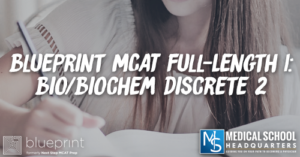Apple Podcasts | Google Podcasts
Session 216
In this episode, Madeline and I attacked the second set of bio/biochem discrete set. Topics include hormones, cell cycle, neurons, lab techniques, and genetics.
The great thing about discrete questions is you are more able to predict the answer choice going into them based on your content knowledge.
Unlike passages where you really have to analyze and connect the dots, going through the discrete questions can be relieving because you can somehow take a breath and take them one at a time.
We’re joined by Armin from Blueprint MCAT. If you would like to follow along on YouTube, go to premed.tv.
Listen to this podcast episode with the player above, or keep reading for the highlights and takeaway points.
[03:34] Question 27
Stimulation of the iris dilator muscle is a result of activation of:
- sympathetic motor neurons.
- parasympathetic motor neurons.
- the fifth cranial nerve.
- sympathetic sensory neurons.
Thought Process:
Think of sympathetic motor neurons as sympathy or like at heart. So it’s going to have to do with increasing your heart rate and increasing your respiration and really trying to get ready for it.
And so, when we dilate our eyes, we’re actually allowing more sun to get in or more light in order to help us see better. And that actually aids in that idea of fight or flight.
So just with that information, we actually might be able to say, it’s actually going to be A because it has to do with our fight or flight.
Correct Answer: A
[07:36] Question 28
Increasing plasma concentration of aldosterone is most likely to be followed by which of the following?
- Increased water reabsorption through increased aquaporin channels in the collecting duct
- Increased sodium reabsorption in the distal tubule
- Decreased water reabsorption in the collecting duct
- Decreased plasma calcium concentration
Prediction:
Aldosterone is a hormone that goes through your blood and it’s going to try to increase your blood pressure via interacting on the kidneys to absorb your sodium. So it’s basically sodium conservation. So just with that definition, you’d go into this and get the answer correct.
Thought Process:
A – This didn’t say anything about sodium reabsorption. So we’re going to cross this out.
C – This doesn’t make sense based on our prediction
D – This doesn’t talk about its actual effects necessarily. Also, we said reabsorption is the big thing that it does with sodium. So that also wouldn’t make sense.
So based on the prediction, B is going to be the right answer here.
Correct Answer: B
[09:13] Question 29
When normal human cells are grown in culture, they will divide a limited number of times – typically 50 rounds of mitosis. After this number is reached, the cells become apoptotic. This cell death is a result of:
- decreasing number of membrane-bound organelles per cell.
- decreasing number of non-membrane-bound organelles per cell.
- decreasing levels of growth hormone.
- chromosomal telomeres shortening after each round of division.
Thought Process:
The science section basically allows any outside knowledge. Maybe you didn’t actually know what telomeres are. But maybe you came across beauty products, specifically, anti-aging creams advertising that maintaining your telomeres is important for having that fountain of youth. And so, that’s how you got that information.
And if that’s how you get that correct answer, then it doesn’t matter if you don’t know the exact mechanism. It’s not like CARS where you can’t bring in outside information.
Correct Answer: D
[11:00] Question 30
A student finishes an experiment involving several bacteria which are highly pathologic in humans. She wishes to dispose of the agar plates and micropipette tips she used. Which of the following procedures should she carry out?
- Microwave all materials for more than 60 seconds.
- Wipe down all materials with a 100% ethanol solution.
- Place all materials in an open metal container and autoclave the container.
- Place all materials under a UV light for 90 seconds.
Thought Process:
When we’re talking about experimental design, especially within a lab, “dispose of” doesn’t mean to just throw away.
A & C – We can cross these out because the time element for both is just not strong enough.
B – There’s a high likelihood that even if you wipe down those materials with 100%, ethanol five or six times that you still didn’t do it at 100% efficacy. Because of that, it brings a measure of error.
C – Autoclave is the strongest thing here. It’s used in hospitals and in labs, and they’re not really telling us the types of materials that are necessarily going in there.
Now, students might think there are things that can go in and that can’t go in an autoclave. But the question is asking what’s going to kill the stuff. So definitely, the autoclave is the answer here because it’s just the strongest.
Sometimes, students overthink it. And so, you just have to have confidence in yourself. If you think that you know it, then you might know it. That’s a great thing to know, to feel, and to allow yourself to have those answers where you know and you can go on.
Correct Answer: C
Links:
SEARCH SITE
SEARCH SITE
LISTEN FOR FREE












